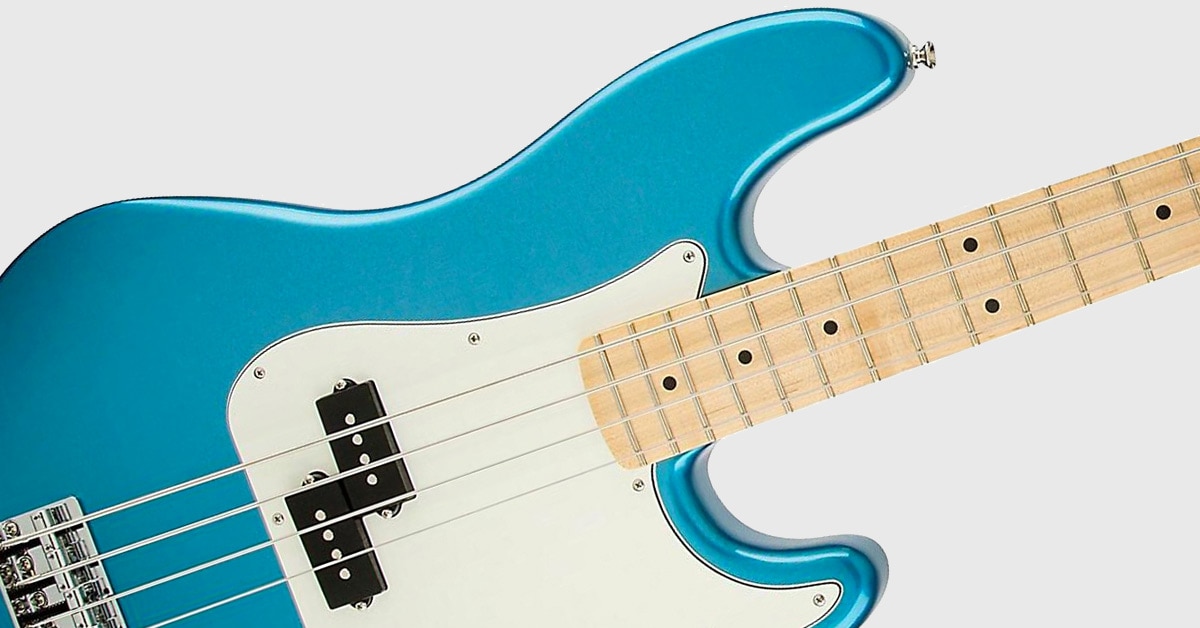The bass guitar anchors the sound and adds flavor to the rhythm in just about every music genre.
An experienced player can also contribute rich harmonies and surprising, low-end solos on the electric bass. Because it's used in virtually every style of modern music, bass players can easily find a band to work with. The bass is also comparatively simple, straightforward, and fun to learn. Still, it does help to know a few bass basics when choosing an instrument for the first time.
Table of Contents
Purpose and Budget
Bass Construction and Design
Types of Bass Necks
Bass Scale Lengths
Electric Bass Body Types
Bass Bridges
Pickups: Single-Coil or Humbucker
Electronics: Passive vs. Active
How Many Strings?
Fretless Basses
Bass Tonewoods
So Which Bass is Right for Me?
Purpose and Budget
Bass guitars vary widely in quality and price, so before you start shopping, determine how much you want to spend.
For beginners unsure of their talent or dedication to learning to play the bass, there are many good, affordable “starter” basses available. These instruments tend to have lower quality hardware and electronics, but they are typically very playable and will serve a new bassist well through the early stages of learning and performing with the instrument.
However, more experienced or dedicated players may want to set their sights a little higher, and invest in a bass guitar with richer tonewoods, better electronics, and upgraded hardware. A higher-quality bass will sound better, feel better, and serve a musician longer.
Bass Guitar Construction and Design - Parts And Their Functions
It’s important to have a good understanding of the basic parts of a bass guitar before you start shopping. Understanding how the instrument is designed and built, and knowing what the different parts are called will help you ask good questions and make informed decisions.
Neck
The neck of a bass guitar, like the neck of any guitar, includes the headstock, fretboard and internal truss rod, which connect to the body of the bass.
Headstock
The headstock is the wide portion at the top of the neck, where the bass strings terminate at tuning pegs. These tuning pegs—also called tuning keys, tuning machines, or tuners—adjust the tension of each string, changing the pitch. The strings are routed down the neck by the nut—a notched strip of hard plastic or bone attached to the top of the fretboard where the headstock meets the rest of the neck.
Fretboard
The fretboard or fingerboard is usually a thin piece of wood— typically rosewood, maple, or ebony. All are excellent woods for the purpose but can vary in quality. The best fretboards are smooth, hard, and dense so that they wear slowly. Fretboards are usually arched from side to side. This arch is called the radius, referring to an imaginary circle that would be formed if the arch of the fretboard were extended to make a circle. Some bass fretboards are close to flat, while others may have a radius as short as ten inches. The shorter the radius, the more pronounced the arch of the fretboard. The fretboard is embedded with frets which are narrow strips of metal. These frets divide the neck into half-step increments, and determine where each note is played along the length of the neck.
A few electric basses are fretless, allowing smoother glissando effects but also requiring greater skill on the part of the bassist. They’re not usually a good choice for beginning bassists.
Some basses have fretboards that are an integral part of the neck rather than being a separate glued-on layer.
Truss Rod
Inside the neck is a metal truss rod that helps prevent the neck from bending or twisting. Bass strings are thicker than guitar strings and create a lot of tension on the neck. Truss rod adjustments allow the neck to be straightened if it becomes bowed or twisted, and are also used when adjusting string height for optimal playability.
Types of Bass Necks
There are three kinds of bass guitar necks, their names indicating the manner in which the neck attaches to the body:
- Bolt-on neck
- Set neck
- Thru-body neck
Most basses have bolt-on necks, which mean the neck is bolted onto the body. The bolts should keep the neck stable and not allow it to shift up or down. A solid, tight connection between the neck and the body is essential. It is also good to have more rather than less overlap of neck and body for greater stability, better string vibration transfer, and enhanced sustain.
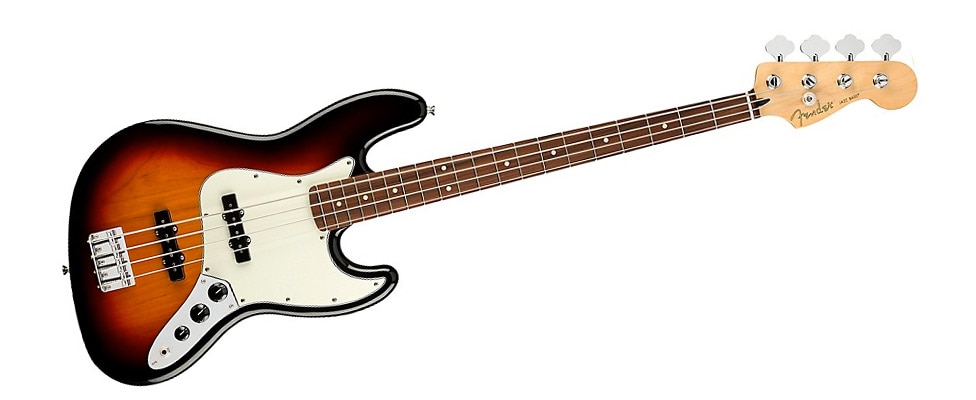
The Fender Player Jazz Bass has classic bolt-on neck construction.
Some bass guitars have set necks, meaning the neck is attached to the body with a mortise or dovetail joint rather than being bolted to it. A set neck creates better resonance and sustain, but can be more difficult to adjust.
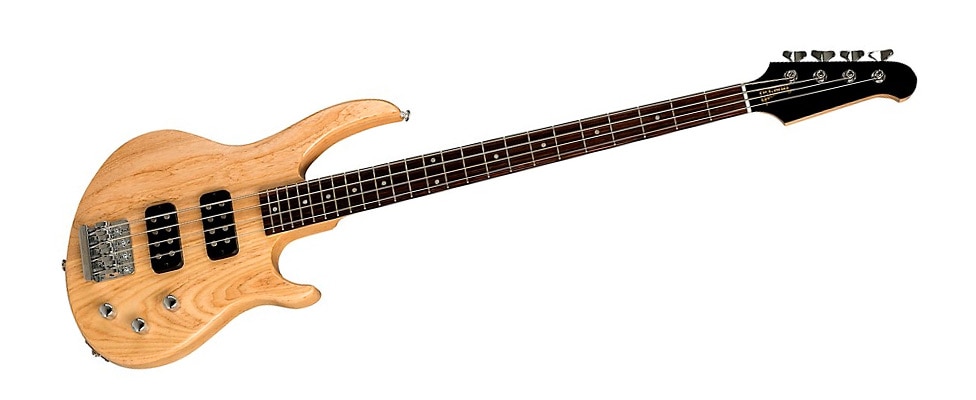
The EB-4 Electric Bass has traditional Gibson set-neck construction.
Thru-body necks are found on higher-end bass guitars. This type of neck continues as one continuous piece through the body. Wings are attached to each side of it to form the upper and lower parts of the body. With a thru-body neck there is no joint between the neck and body that can inhibit vibration, resulting in better response and sustain.
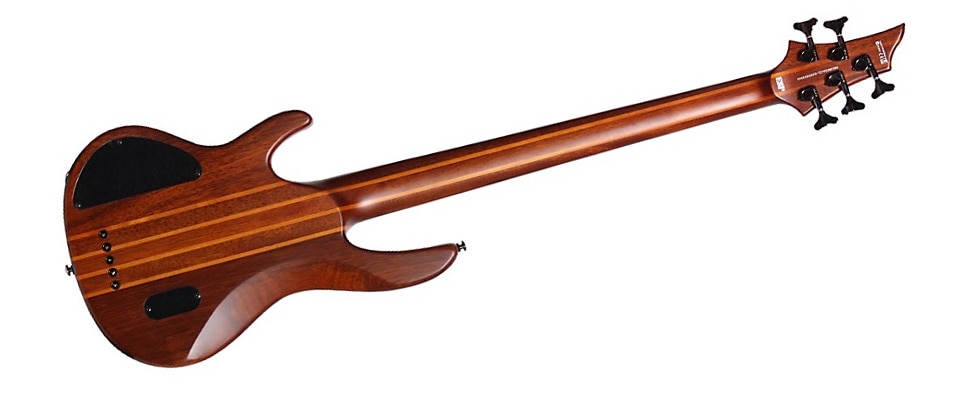
The ESP LTD-5 5-String Bass has a thru-body neck.
Bass Scale Lengths
Scale is the length between the nut (the notched piece between the fretboard and the headstock) and bridge where the strings are anchored at the tail end of the body. The most common scale length is 34".
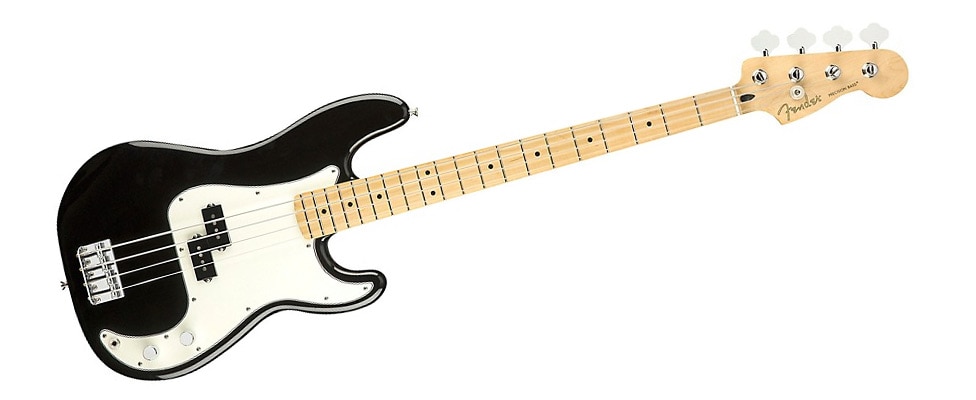
With its 34” scale, the Fender Player Precision Bass is typical of most other standard-size electric basses, which share its scale length.
There are a few short-scale basses, such as the Fender Mustang, various Hofner Violin Bass models, or the Gibson EBO, that are around 30". These are a good choice for young players with small hands who may have trouble playing a standard-size instrument.
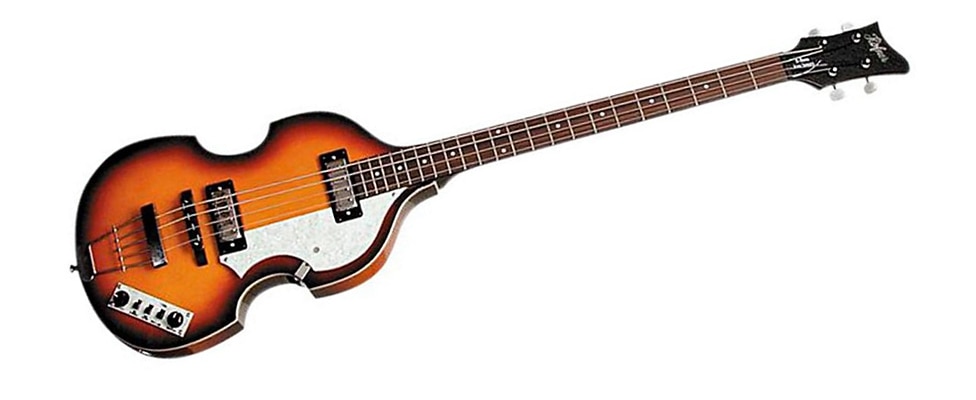
The Hofner Ignition Series Violin Bass has a shorter 30” scale and is based on the model made famous by Paul McCartney.
A long-scale neck usually has a 35" scale. This longer scale gives you a few more frets, and is most often used for five- and six-string basses because it improves string tension and minimizes floppiness on the low strings.
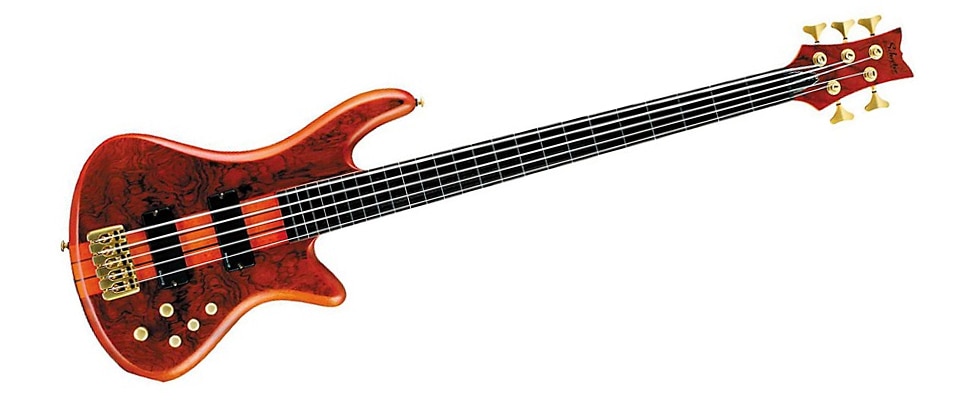
The Schecter Stiletto Studio-5 5-String Bass has a longer-than-average 35” scale.
Electric Bass Body Types
Solidbody basses are the most common type. In better instruments, these bodies are often made of a solid piece of wood—alder, maple, swamp ash, mahogany, or some other wood that transfers vibration well. In lower-priced basses, the bodies may be made using laminated wood plies, softer woods, or pressed woods. There are even basses with plastic bodies.
Hollowbody basses, as you probably guessed, have a hollow body like an acoustic guitar but use the same magnetic pickups as solidbody basses. They are used mostly by jazz and folk players, and for music that is quieter and requires a more acoustic-like tone. A famous hollowbody, the Hofner violin-shaped "Beatle" bass, is an example of a hollowbody used for rock music. Hollowbody basses have the advantage of being lighter, but they usually are more limited in the volume they can produce because they feed back more easily than solidbody basses at high volume. There are also a few semi-hollowbody basses that have a solid center block and hollow outer halves of the body. They are less prone to feedback.
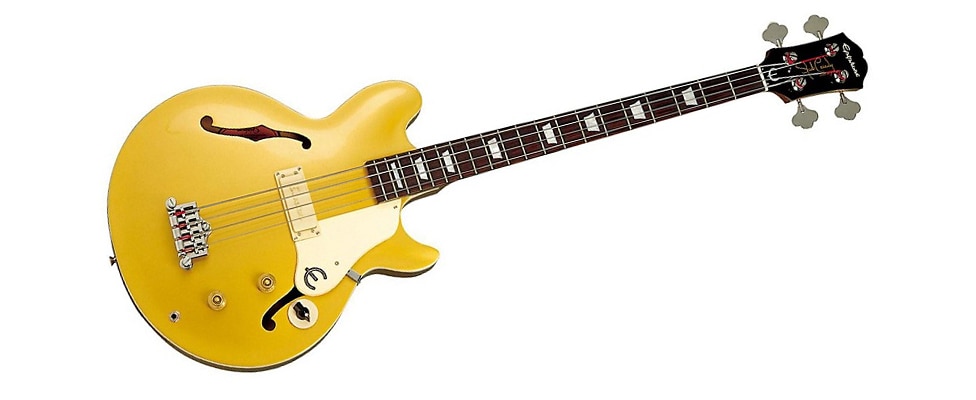
The Epiphone Jack Casady Signature Bass has a semi-hollowbody design that produces an acoustic bass-like tone while resisting feedback.
Another type of hollowbody bass is the acoustic-electric. This is really an acoustic instrument built similarly to an acoustic guitar and usually equipped with a piezo pickup that allows it to be amplified. Most often the piezo pickup is located under the bridge, while an onboard preamplifier allows tonal adjustments when the bass is amplified.
Bass Bridges
The bass guitar’s strings terminate at the bridge, where their vibrations are transmitted to the body creating the resonance and tone that the pickups capture and amplify. The strings pass over notches, called bridge saddles, which can be moved up and down to adjust the action, or forward and back to adjust the intonation. Better bridges are made of brass, and are often plated with chrome or nickel silver. A bridge with more mass and weight will usually anchor the strings better and transfer more vibration from the strings to the body.
There are three different bridge types on most electric bass guitars:
- Through-bridge
- String-through body
- Bridge and tailpiece combination
On a through-bridge, the strings are threaded through the back of the bridge, and over the saddles. On a string-through body bridge the strings are fed through the body of the bass and over the saddles. A bridge and tailpiece combination feeds the strings through a separate tailpiece that’s unconnected to the saddles.
Pickups: Single-Coil or Humbucker
Pickups are electromagnetic devices that capture the sound created by the vibrating strings and body of the bass, converting it to an electronic signal. Most bass guitars have two sets of pickups to provide a greater tonal range. Pickups nearer the fretboard have a smooth, low-end sound, while the pickups closer to the bridge have an edgy, mid- to high-end tone.
The most common types of pickups are single-coil and humbuckers, and most others are simply variations on one of these two types.
Single-coils were the first kind of pickups and the most simple. Each pickup has only one coil and one magnet, which creates a bright, focused sound. Single-coil pickups can be noisy, however, which is why humbucking pickups were developed.
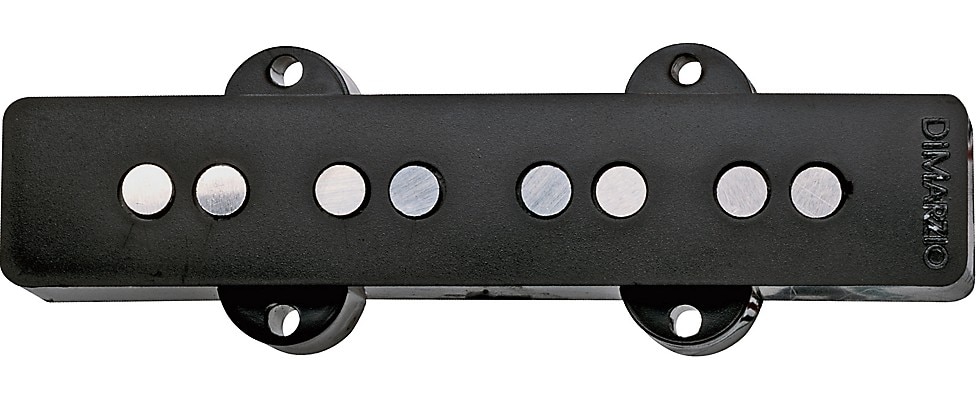
The DiMarzio DP148 Ultra Jazz Bass Bridge Pickup is a modern single-coil design that eliminates hum while expanding the traditional sound of a Fender Jazz Bass.
Humbucking pickups were created in an effort to cancel the hum or noise of the single-coil, but they also have a fatter sound in addition to being more noise-free. The humbucker sound can get muddy at higher volumes though.
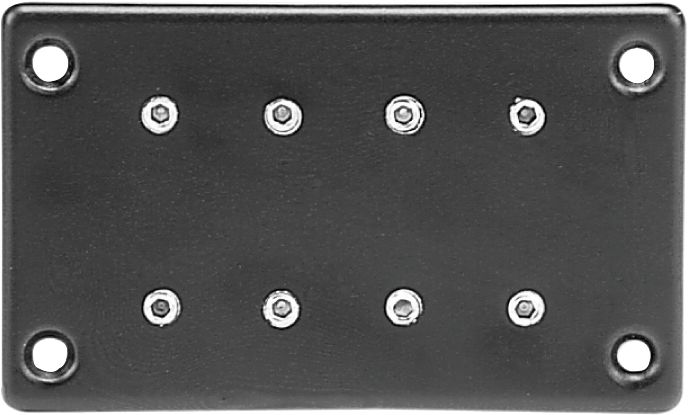
The DiMarzio DP1 DP120 Model One Bass Humbucker has many applications, and can be used in woofer/tweeter setups for extreme frequency range control.
One common variation is the split-coil (the design found on the Fender Precision Bass). It is a single-coil wired to function like a humbucker. Two halves of the pickup are separated and one side is reversed in polarity to the other. Thus, you get a tone that is closer to the single-coil sound, but with the quietness of the humbucker.
Electronics: Passive vs. Active
The terms active and passive refer to the preamp circuitry of the bass. The preamp boosts the pickups’ output and provides tone-shaping controls.
Passive preamp systems operate without any power source and have fewer controls, usually a volume knob, a tone knob, and a blend control if there are two pickups. One advantage of the passive bass is that it doesn't depend on a battery that can die in the middle of a gig. Another plus is the simplicity of operation. Passive electronics have a more traditional low-fi sound that some players to the hi-fi sound of active electronics.
Active basses need power, usually provided by an onboard battery. The advantage of an active preamp system is stronger output and more control over tone shaping. Active basses often have separate EQ controls divided into frequency bands, such as a low-, mid-, and high-frequency boost/cut controls. They can also have contour switches which instantly reshape the EQ profile. Some have controls that let you change the wiring of your pickups on the fly from series to parallel for dramatic tonal shifts. A coil tap switch found on some basses with active electronics deactivates one set of coils in a humbucking pickup to make it sound like a single-coil.
How Many Strings?
Four-String Bass Guitars
Most bass guitars have four strings and new players should probably start with a four-string bass. These basses are perfectly adequate for most musical styles, and the necks are smaller than those on five- and six-string basses, making them easier to handle and learn with.
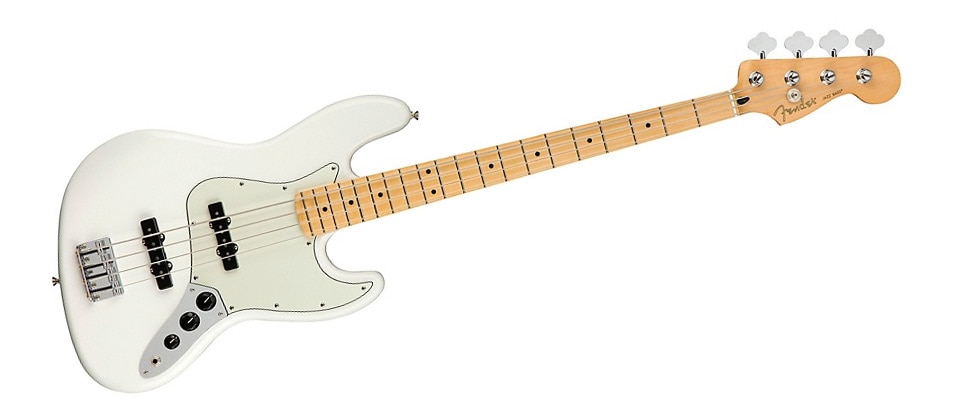
The 4-string Fender Player Jazz Bass is among the most iconic electric basses ever; the original having been developed in 1960 by Leo Fender.
Five- and Six-String Bass Guitars
Five-string basses add a lower B string, giving the instrument a deeper range. The neck of a five-string bass is necessarily wider than a four-string, making it a little harder to play. Five-string basses are popular with some hard rock, metal, fusion, and jazz bassists.
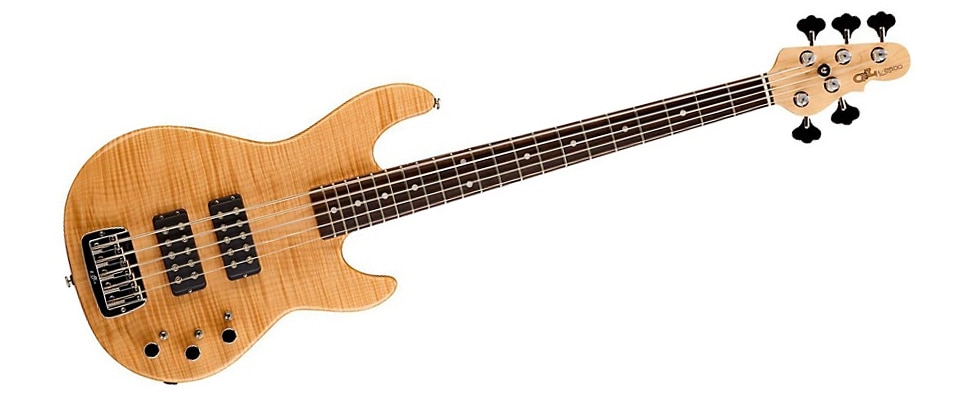
With its additional low B String the G&L L-2500 5-String Bass offers extended range.
Six-string basses have an even more extended range due to their low B string and high C string. Six strings require a wider neck yet, which can be difficult for many players to handle. Though challenging, they’re ideal for bass players who do a lot of soloing as they widen the range and provide room for greater creativity.
Fretless Basses
Standard bass guitars have fretted necks, with metal frets dividing the fingerboard into half-step increments. These frets make it easy to see where each note is played on the neck.
A fretless bass, however, has a smooth neck, similar to an upright bass or violin. Hitting the right notes with the right intonation is challenging and not for beginners. Fretless bass players rely on muscle memory and a well-trained ear. They choose the fretless bass for its smoother, warmer sound and its ability to provide glissando effects like a standup acoustic bass.
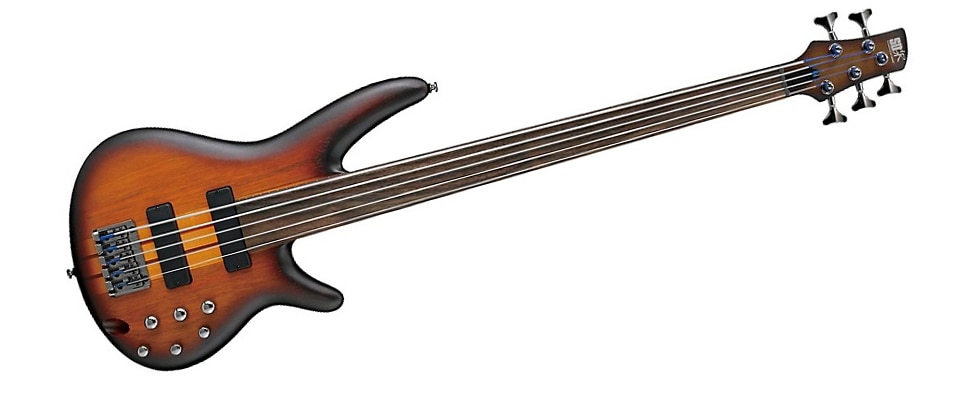
The Ibanez SRF705 Portamento 5-String Fretless Electric Bass delivers powerful tone, but is more challenging to play than fretted basses.
Bass Tonewoods
The type of wood that is used in the body of the bass guitar will impact its tone and resonance. New players don’t need to be too concerned with the type of wood used for their bass guitar body. But if you are looking for a specific sound from your bass, then the body wood could be an important factor.
Alder
Alder is often used for bass guitar bodies. It creates a very balanced tone, with great clarity and a very full sound.
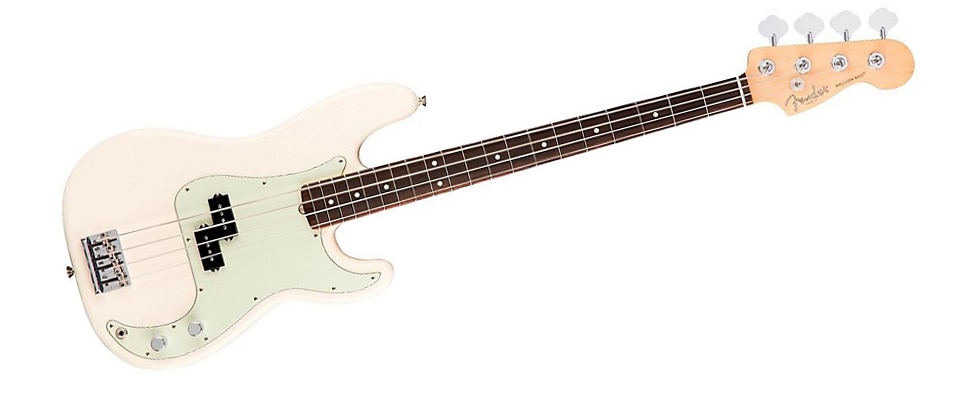
The alder body of the Fender American Professional Precision Bass produces great clarity and sustain.
Agathis
Agathis is a popular body wood because it is relatively inexpensive. It provides a fairly balanced tone with a slight emphasis on low-mid tones that gives it a rich sound.
Ash
There are several species of ash used on bass guitar bodies, with subtle differences, but in general the wood produces a bright, full sound, similar to alder. Swamp ash is especially desirable due to its beautiful grain.
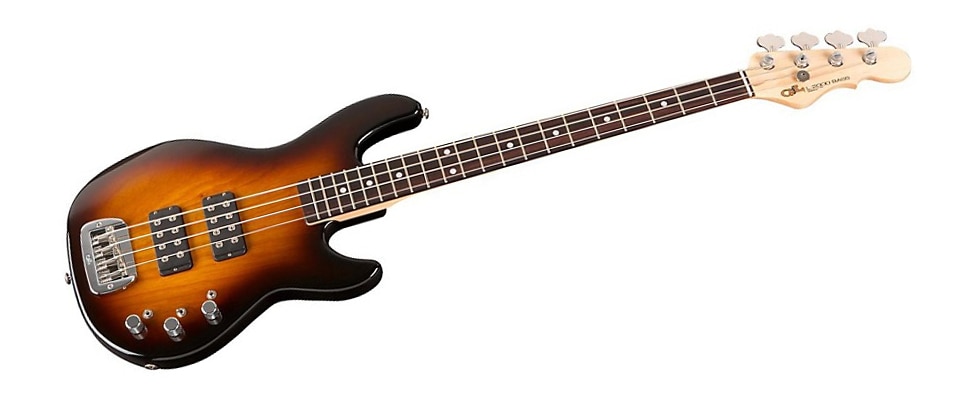
A burst finish applied to the swamp ash body of the G&L L-2000 Bass adds beauty to the wood’s natural figuring and resonance.
Basswood
Frequently used on less expensive instruments, it is a softer wood that does not resonate as much as other tonewood options. Some bass players think this creates a flat sound, while others feel the short sustain is ideal for fast, complex playing techniques.
Mahogany
Mahogany is a popular tonewood for bass guitars because it produces a soft, warm tone that emphasizes the low-mid and lower-range tones, and creates longer sustain. It is a dense wood, however, and will feel heavier on your shoulder than ash or agathis.
Maple
Maple is also a dense wood, so it creates a well-sustained sound like mahogany. Maple, however, produces a bright, clear tone that many musicians find valuable in a studio setting.
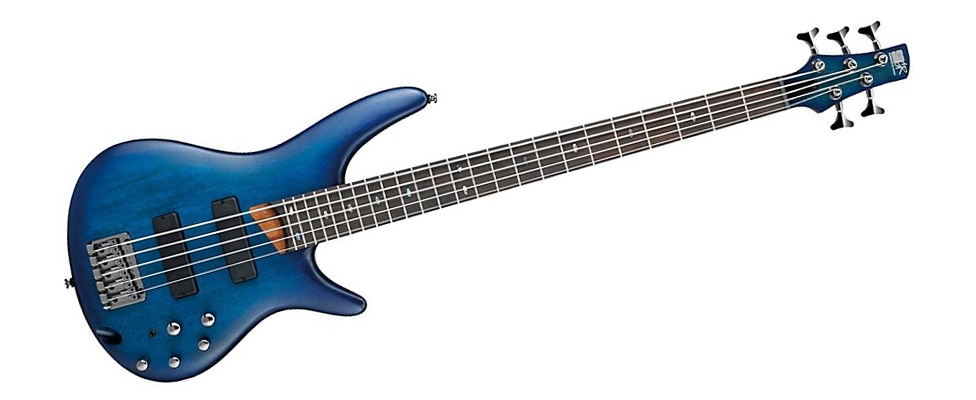
The NS Design CR5 Radius Fretless Bass has a maple body with lavishly flamed top that combines with an innovative neck design and pickup system for stunning sound, playability and visuals.
Many other woods are used for bass bodies. High-end models may be made of exotic species such as bubinga, wenge, koa, or cocobolo.
So Which Bass is Right for Me?
Here are a few guidelines (not rules) for the first-time bass buyer:
- Buy the best bass you can afford. A good bass will make learning easier and you won't outgrow it as quickly.
- Choose a fretted instrument, unless you are ready for the challenge of a fretless.
- Choose a short-scale bass if you are young, small, or have unusually small hands.
- For simplicity's sake, choose a 4-string instrument.
- Select a bass with simple controls so you can focus on the strings and not be distracted by knobs.
- Choose a bass in a color and shape that appeals to you. Its looks won't make it sound better, but a cool-looking bass can motivate you to play more.





































































































































